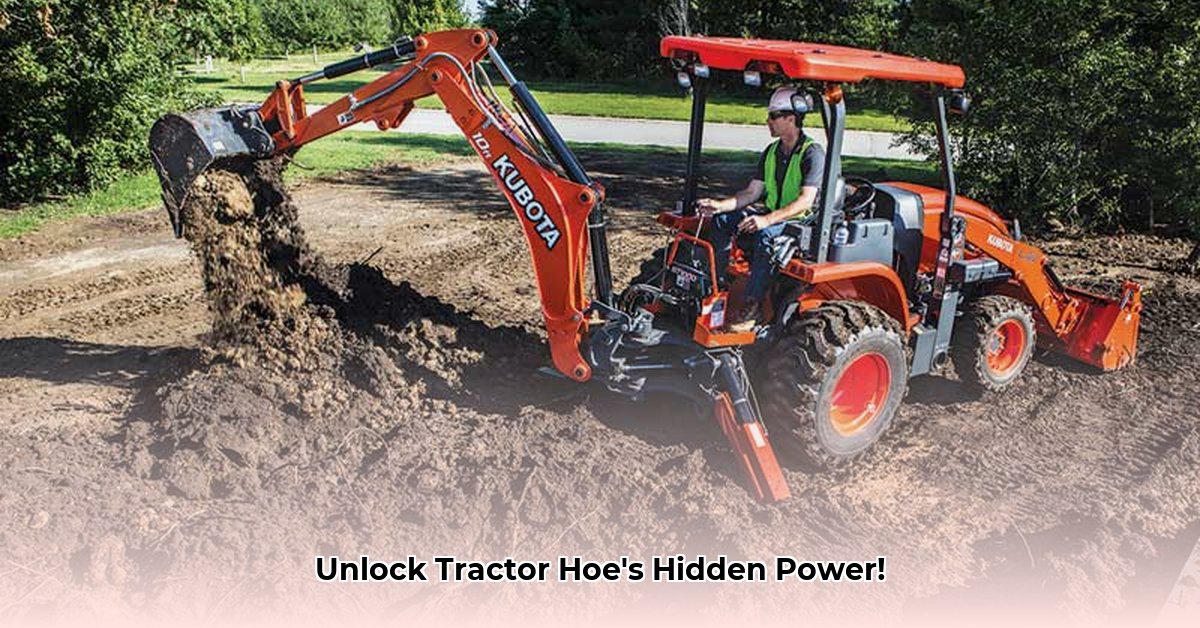
Understanding Tractor Hoes in Sustainable Agriculture
Sustainable agriculture demands efficient practices that minimize environmental impact. The tractor hoe, a seemingly simple tool, plays a surprisingly significant role. Its ability to precisely remove weeds, reduce reliance on chemical herbicides, and minimize soil disturbance aligns perfectly with sustainable farming principles. But, as with any tool, optimizing its use is key to maximizing its benefits. How can we ensure that our use of tractor hoes truly promotes sustainability? For more on sustainable tools, check out this helpful resource on chicken tractors.
Advantages of Tractor Hoes for Sustainable Farming
The benefits of tractor hoes in sustainable agriculture are multifaceted:
Reduced Herbicide Use: By physically removing weeds, tractor hoes significantly decrease the need for chemical herbicides, minimizing environmental contamination and promoting healthier soil ecosystems. This directly addresses soil pollution and the health concerns associated with herbicide residues in food.
Improved Soil Health: Minimal soil disruption from appropriate tractor hoe usage maintains soil structure, improving water retention and aeration. This leads to healthier soil ecosystems, fostering microbial activity vital for nutrient cycling and plant growth. A healthy soil structure is crucial for carbon sequestration and water conservation in arid and semi-arid regions.
Cost-Effectiveness: While initial investment is required, long-term savings can be achieved through decreased herbicide costs and potentially increased crop yields due to improved soil conditions. The initial capital expenditure pays for itself over time, leading to more economical farming practices.
Versatility and Adaptability: Many tractor hoes are adjustable, making them suitable for diverse crops and soil types, providing farmers with a flexible and efficient tool for weed management. Their adaptability makes them suitable in a variety of agricultural settings.
Challenges and Limitations of Tractor Hoe Use
While offering significant advantages, tractor hoes also present challenges:
Time Investment: Efficient tractor hoe operation requires skill and practice. Farmers need to learn optimal techniques to maximize efficiency and minimize potential crop damage. Improper use can negate the benefits and waste resources.
Potential for Crop Damage: Incorrect usage can cause unintentional crop damage, negating the positive effects and leading to lower yields. Precision and careful operation are crucial.
Terrain Limitations: Certain terrains (e.g., very rocky or sloped areas) may not be suitable for tractor hoe usage. Farmers need to assess their specific fields before investing in these tools. Alternatives should be considered for unsuitable areas.
Optimizing Tractor Hoe Techniques for Sustainability
Effective tractor hoe usage hinges on several key practices:
Precise Timing: Early weed removal is crucial. Addressing weeds before they become established minimizes competition for resources and reduces the overall time and effort required. This is essential in both high-yield and ecological practices.
Depth Control: Careful adjustment of hoe depth is essential to avoid damaging crop roots. Understanding soil type and crop root systems is critical for optimized operation. Correct depth is key to preserving root growth and preventing soil compaction.
Regular Maintenance: A well-maintained tractor hoe ensures optimal efficiency, minimizing time, fuel consumption, and effort. Regular maintenance extends the lifespan of the equipment and maximizes its overall cost-effectiveness.
The Future of Tractor Hoe Technology
Innovation in agricultural technology continues to shape sustainable farming. Future tractor hoes may incorporate:
Precision Guidance Systems: Sensor-guided tools that precisely target weeds while leaving crops unharmed can significantly reduce environmental impact and increase efficiency. AI-powered systems can further enhance precision and minimize resource use.
Sustainable Materials: The use of recycled or biodegradable materials in manufacturing can minimize the environmental footprint of tractor hoe production. This moves towards a circular economy in agriculture, reducing landfill waste and promoting sustainable manufacturing practices.
Integrated Weed Management: Combining tractor hoes with other sustainable weed management techniques (e.g., cover crops, crop rotation) can create a holistic and synergistic approach, further optimizing resource use and environmental protection. This integrated approach improves overall sustainability and increases agricultural productivity.
Actionable Steps for Sustainable Tractor Hoe Use
| Stakeholder | Short-Term Actions | Long-Term Strategies |
|---|---|---|
| Farmers/Producers | Evaluate current weed control; trial tractor hoes; refine techniques; seek training. | Invest in precision agriculture technologies; adopt integrated weed management; monitor soil health indicators. |
| Equipment Manufacturers | Develop more efficient and sustainable designs; explore lightweight materials; improve durability. | Research and develop autonomous or AI-guided tractor hoes; focus on sustainable manufacturing practices and materials. |
| Policy Makers | Provide incentives for sustainable weed management; support research & development; promote best practices. | Invest in educational programs; revise regulations to encourage sustainable agriculture technologies; fund research. |
Dr. Anya Sharma, Professor of Sustainable Agriculture at the University of California, Berkeley, states, "The tractor hoe, when used correctly, offers a powerful tool for sustainable farming. However, its effective integration requires thoughtful planning, appropriate training, and a holistic approach to weed management."
Sustainable farming requires a continuous commitment to improvement. The tractor hoe—with its versatility, potential for technological advancement, and alignment with sustainable principles—remains a valuable tool in creating a more environmentally responsible and productive agricultural future.